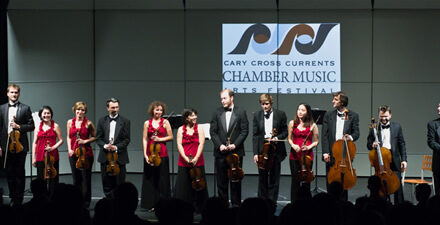“Conductor’s candy” was how departing Music Director Stuart Malina described his sure-fire crowd-pleasing program during a well-attended “Meet the Artists” session after a stirring evening of music with the Greensboro Symphony on May 8, in Greensboro’s War Memorial Auditorium. Reaching back to his first audition concert with the GSO, he ended the concert with Tchaikovsky’s Symphony No. 4 in F Minor, Op. 36, certainly a standing ovation item. From his first season, he chose Bernstein’s galvanic Symphonic Dances from West Side Story . Because it is the only work that he conducts from the keyboard and because it was on his second season, he added Gershwin’s “Rhapsody in Blue.” Malina said he was surprised and touched by the prolonged spontaneous standing ovation that greeted his appearance on the stage. During the informal session, he said that he was not breaking his ties with the GSO, which has meant so much to his growth – he will conduct a February 2004 set of concerts, and he plans to keep his ties with Greensboro. This was thus “see you again” and not “goodbye,” which he expressed as “au revoir” but “not adieu.”
The Symphonic Dances from Bernstein’s West Side Story received a vital, white-hot performance. The attacks were crisp, string-versus-brass balances were good, and the phrasing was idiomatic, right down to the snapped fingers. The pizzicati were superb throughout. Simple, breathtaking beauty was conveyed in “Somewhere,” which opened with Scott Rawls’ sonorous viola, joined shortly by Concertmaster John Fadial and Principal Cellist Beth Vanderborgh, before the full strings joined in. The woodwinds were excellent, the percussionists had a ball, and the brass were in very good form all evening.
While Malina was the assistant conductor of the Charleston (SC) Symphony, he toured nationally with a production of Gershwin’s Porgy and Bess . This experience helped give him a natural feel for the composer’s idiom. He played the solo piano part and conducted the GSO in Gershwin’s “Rhapsody in Blue,” opened perfectly by Kelly Burke’s brash and sassy clarinet. All sections more than fulfilled the requirements of the Grofé orchestration, and the muted trumpets were especially fine. Malina several times stood at the keyboard to conduct tricky spots, but soon he had his hands full, delivering an incandescent rendition of the jazzy piano part. Malina later mentioned that, in rehearsals, he often had the orchestra play alone without his conducting, urging them to listen to each other. This training paid dividends during the later third of the “Rhapsody.”
While he didn’t take any radical interpretative stances in the Tchaikovsky’s Fourth Symphony, Malina managed to make it seem fresh. All the players were alert, playing their hearts out. The string sound was full and rich, and the cello section was superb in the second movement. As noted, the brass had a good night, and the horns, led by Robert Campell, were in rare form. Splendid solos were played by oboist Cara Fish, flutist Debra Reuter-Privetta, clarinetist Burke, and bassoonist Carol L. Bernstorf. I don’t ever remember hearing quite so much raspy tuba sound as David Nicholson produced, but Malina’s conducting clearly indicated that was what he wanted. Perhaps the effect resulted from the blending with the bass trombone.
In the informal after-concert session, a Malina innovation that his successor, Dmitry Sitkovetsky, ought to retain, the conductor touched on a broad range of topics. His explanation of how he went about setting up programs and soloists for a season was engrossing. He said he felt no reservations about the future of the GSO with a musician of his successor’s standing. He said that Sitkovetsky would be able to take the orchestra in a different direction – that they had completely opposite approaches – but that both shared excellent “people skills.” He listed the works that had stood out for him: Mahler’s Fifth Symphony was the most challenging, and working with passionate amateur choruses had been rewarding; Bloch’s Sacred Service , from his own religious tradition; and Verdi’s Requiem . Between the Thursday and Saturday performances of the later, his grandfather had died, which added to the challenge of performing and concurrently became a source of catharsis. Comparing his audition performance of the Tchaikovsky, he said that during that first reading, when things started to come apart, the orchestra took longer to gel. During the May 8 performance, such moments were rarer and recovery was more prompt since they were used to playing together. Malina also discussed his uncredited musical role in the creation of Twyla Tharp’s Movin’ Out , based on the music of Billy Joel. He said he spent much of his free slots for a year working with Tharp before the show’s somewhat mixed debut in Chicago. After heavy “tweaking,” it was critically acclaimed on Broadway and made money despite the events of 9/11, the cold winter, and the recession. I hope Malina will lend Sitkovetsky the names of some of the wonderful rising musicians that he has been able to bring to the Triad, such as violinists Chee-Yun and Pamela Frank and cellist Alban Gerhardt. A friend said these were Malina’s Curtis Institute connections. These artists were refreshing changes from expensive and highly marketed “stars” who can fill seats but too often turn in routine – or worse – performances. Malina has set the artistic benchmark high for Greensboro.
This program will be repeated tonight (May 10) in Greensboro and tomorrow (May 11) at Elon University. See our Triad calendar for details. And see http://www.news-record.com/ae/pantheon/events/malina02.htm [inactive 3/04]for additional information on Malina and the GSO.











